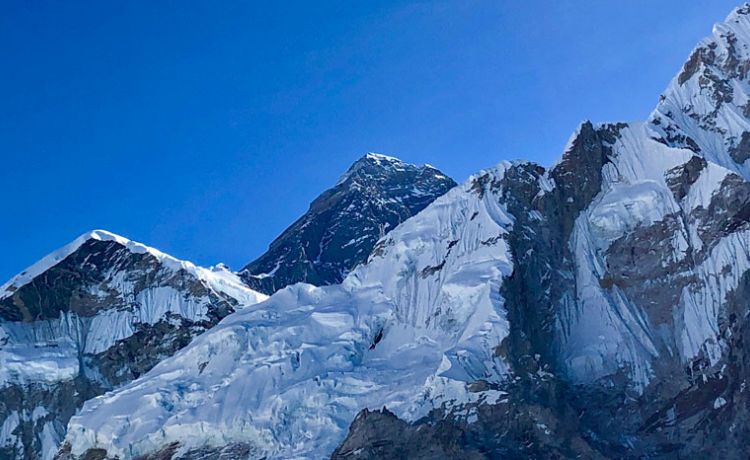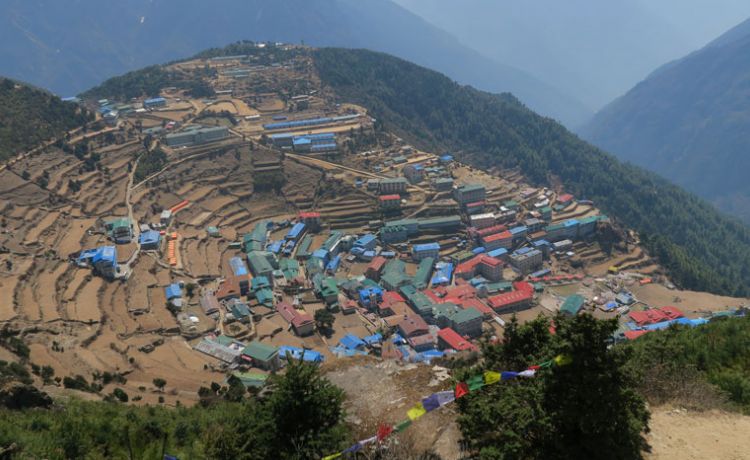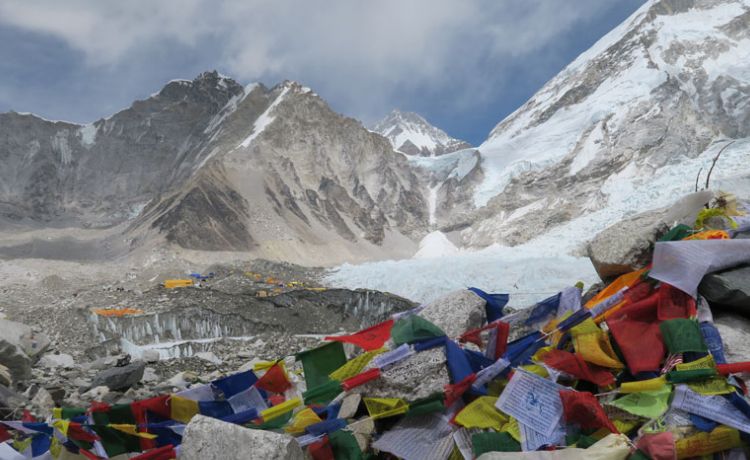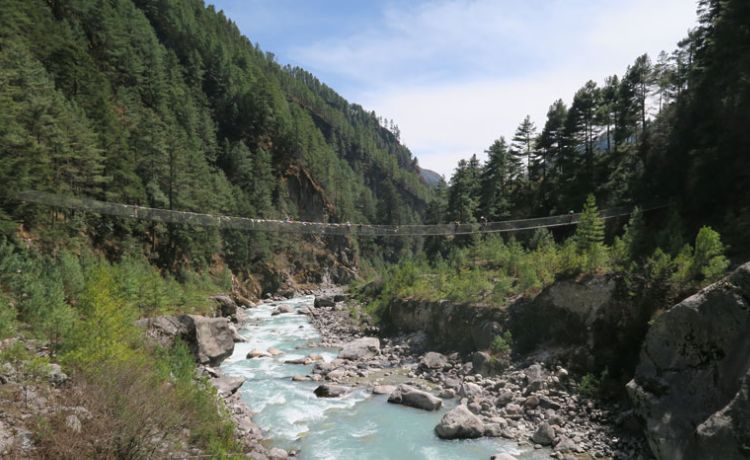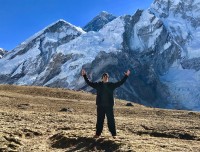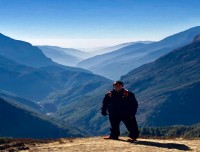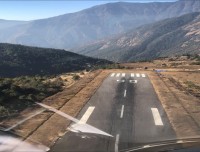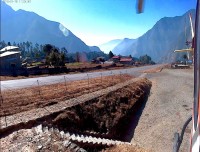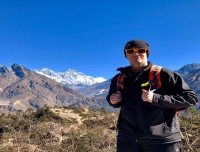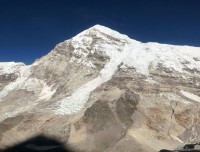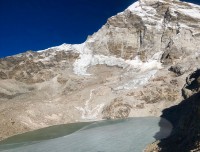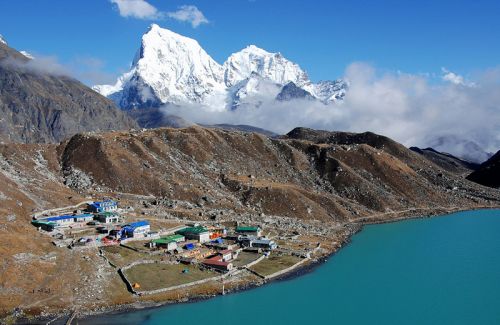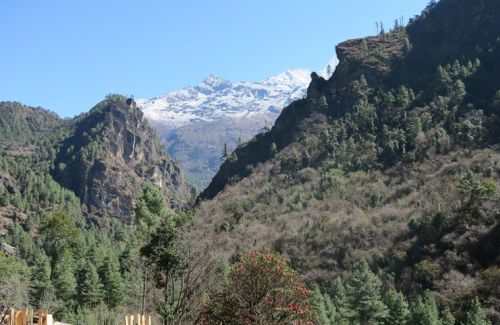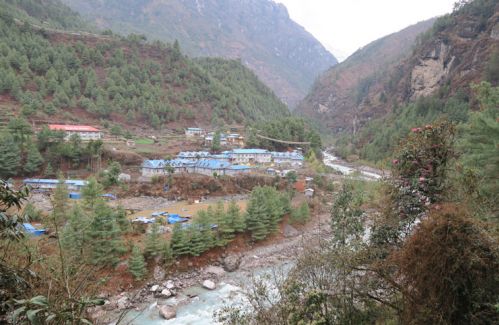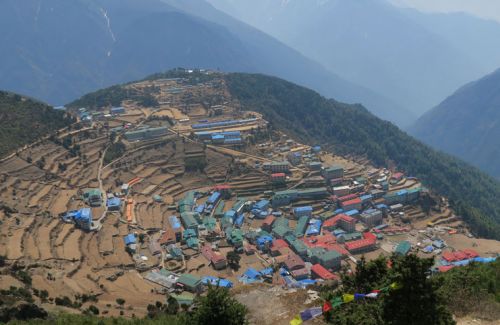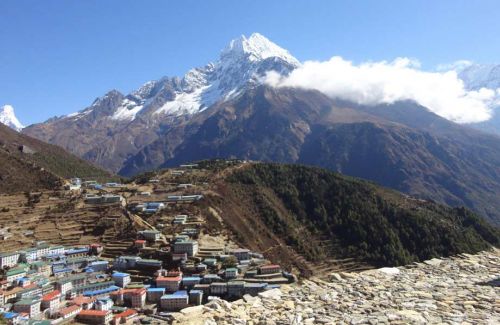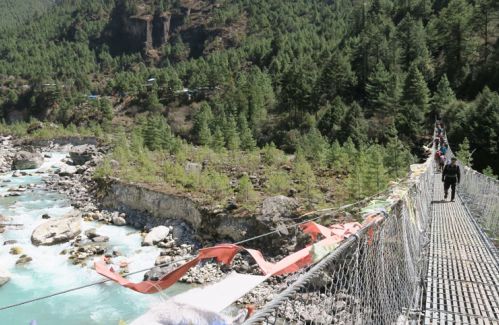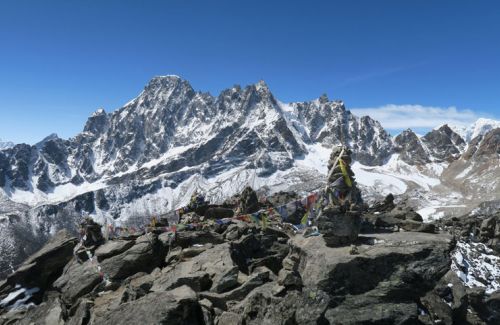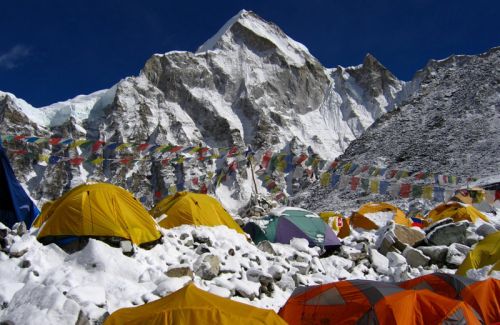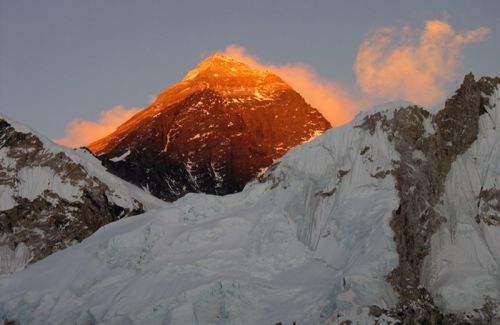EBC Trekking in Nepal
- Duration14 Days
- Max. Altitude5,545 m
Destination:Nepal
Trip Grade:Strenuous (****)
Meals:Breakfast + Lunch + Dinner
Transportation:Private Vehicle / Aeroplane
Accommodation:Lodge
Trekking Region:Everest Region (EBC)
Show AllEverest Base Camp (EBC) Treking as a holiday destination
It is almost impossible to resist the temptation to visit the world’s highest peak. The Everest Base Camp (EBC) Trek is a well-established and popular destination. Besides the once-in-a-lifetime experience of visiting the highest mountain on Earth, this trek also takes you into the heart of the high Himalaya; through local villages and gompas (monasteries) and provides a rich and rewarding experience. For the best experience, it is recommended that you visit between March-May, or between September-December.
While the region was shaken by the 2015 earthquake, only a small number of lodges were destroyed, and the route is once again safe for trekking. Repairs are well underway at the affected villages, and there are open lodges at all the key overnight stops along the route, including the mostly uninhabited upper reaches.
Why EBC Trekking?
Every mountaineer, trekker, or mountain-lover in general aspires to get up close to the Everest. Not only is it the highest mountain in the world but also is the peak of every mountaineer and trekker’s ambitions when it comes to climbing. There are a spectrum of things, expected and unexpected, that you can witness only in the Everest Base Camp Trek. It’s a life-altering experience, to say the least, as was admitted by those who experienced this trek. One starts from the capital of Nepal, Kathmandu, which is an experience to cherish in itself.You can reach a daunting altitude of 5,545m/18,192ft. You get to experience the epic journey that Sir Edmund Hillary and Tenzing Norgay embarked on in the year 1953. While on the trek, you will encounter wildlife that is typical only to the highest of mountains.
Adventure junkies and mountain-lovers, this is one trek that you would want to do once in your life to get up close to the highest and mightiest mountain of the world. With great guides and an amazing tailor-made itinerary, this trek can culminate into a story that you can tell with pride.
Ethnicity/cultural experience
The EBC trail takes you through the Thami and Tengboche Monasteries, as well as more typical Sherpa villages. The Sherpas who live in the mountains of Eastern and Central Nepal are probably the best-known Nepali ethnic group. Originally nomadic Tibetan herders, they moved into the region around 500 years ago from eastern Tibet, bringing with them their Tibetan Buddhist religion and building the beautiful gompas (monasteries) that dot the hillsides. These days, trekking and mountaineering form the backbone of the Sherpa economy, with the tourism industry employing over half of the population as guides, interpreters, cooks, traders, yak and lodge owners and so on. The Sherpas have a reputation of being almost always helpful and friendly, singing and whistling and doing that they can to make your trek enjoyable. Many porters that work along the trails also come from other ethnic groups, such as Tamang or Rai, with their own distinct cultures and traditions.
Getting there/coming back
A return trek to EBC from Lukla takes at least 16 days, but it is highly recommended that you prepare for a longer trip to take in some of the stunning and less-visited valleys. Be sure to also schedule acclimatisation days at Manche and Pheriche to avoid altitude sickness. Alternatively, one way to acclimatise slowly (and beat the crowds) is to walk in from Shivalaya (six days), see more details below:
Access via Lukla (30-minute flight)
To maximise your time in the high Himalaya, you can opt to fly to Lukla from Kathmandu; which runs up to 75 flights daily in high season (US$165). It is recommended to allow yourself a buffer day or two to return to Kathmandu, as flights can be delayed during bad weather.
Access via Shivalaya (6-day trek)
While most trekkers opt to fly, an alternate route is to trek in and/or out from Shivalaya, just past Jiri. Kathmandu’s Ratna Park bus station runs buses to three stops from which the trail can be accessed:
Shivalaya (8am, Rs747, 8 hours)
Bhandar (5:45am, Rs960, 10 hours)
Jiri (6am, Rs930, 6 hours)
Please note that this is route is also physically demanding, as it cuts across valleys requiring numerous descents and ascents. By the time you reach the EBC the accumulated ascents will total almost 9000m; the full height of Everest from sea level!
Scenic beauty
The EBC offers stirring views of the surrounding peaks, such as Ama Dablam, Pumori and Nuptse. The best view of Everest itself is from Kala Pattar or from the Tangboche monastery, both of which are visited during the trek. Most of the trek goes through the Sagarmatha National Park, a UNESCO World Heritage Park (Sagarmatha is the Nepali name for Everest), and home to numerous flora and fauna, including rhododendron forests, Himalayan monal, deer, snow leopards, Himalayan tahr, black bears, as well as the picturesque yak caravans.
Kalapatthar
Kalapatthar is the vantage point, the view point in the Khumbu region from where one could view the Khumbu glacier, lesser mountains, and could feel his dream come true to be on the lap of Mt. Everest. KalaPatthar means the Black rock, situated at the height of 5545 m on the south ridge of Pumori above Gorakshep. The breathtaking views of Everest, Nuptse , Changtse and Lhotse can be seen from here. This is the place everybody would like to summit the next morning of their overnight stay at Gorakshep. Th is the place where helicopter lands when people do helicopter sightseeing to Everest.
So, we start to hike to Kalapatthar early morning from Gorakshep which is at the height of 5,164 m. We pass through an ancient lake bed where there is a small lake and helipad named “The beach”. We ascend through the steep part and the trail goesto the eastern side of the mountain. The way is further steep until it reaches to the top of the ridge where we should struggle to pass the boulders and we can see lot of prayer flags. Generally, it takes 1.5 to 2 hours to be to the top.
Important thing to carry with you:
1) A torch if you go early morning
2) Plenty of water
3) Gloves, down Jacket, beanie, hat etc.
Difficulty level
Trekking in the Himalayas involves multi-day walks and fairly steep climbs, including snow at high altitudes. This requires a certain level of physical and mental fitness. You should be in good overall fitness and health and feel comfortable hiking 10-20km per day carrying a day pack of about 5kg. It is recommended that you carry out at least one hour of aerobic activity 3-4 times per week for at least 1 month before starting the trek. Aerobic conditioning is important, as it enables your body to better metabolize oxygen and prepare for thinner air (there is 40% less Oxygen than at sea level). If you are in any doubt of your physical readiness, please consult with a doctor beforehand. In addition, the high altitude also means that new arrivals can only walk for 5-6 hours each day before stopping for the night to acclimatise. While it may be tempting to continue beyond the recommended 6 hours, it is essential to take it slowly on the first 10 days. Most treks that ‘go wrong’ do so because trekkers have not allowed themselves to acclimatise properly.
In case of emergency, there are hospitals in Jiri, Phaplu and Khunde, whilst the Himalayan Rescue Association has a medical facility in Pherice. In the Gokyo Valley the International Porters Protection Group runs clinics in Macchermo and Gokyo. Most emergency centres also offer a recommended free talk on acute mountain sickness (AMS) at 3pm.
Further afield
It is highly recommended that you add another week or so to explore some of the region’s numerous side trips. A particularly scenic addition is the six-day detour from Namche Bazaar to the Gokyo Valley, with a lake and glacial view from Gokyo Ri (5360m). Another recommended three-day detour is up the Imja Khola Valley to Chhukung, a staging post for climbers heading to Island Peak complete with its own spectacular views. Finally, as an alternative to flying back to Kathmandu, you can take the 9-day teahouse trek from Lukla to Tumlingtar, from where you can continue to Kathmandu by bus.
Packing List
- 2 quick drying long sleeved base layer shirts
- 2 trekking shirts short sleeve
- 2 Thermal underwear2 – base layer
- 2 liner socks
- 3 pair woollen blend trekking socks
- 2 pair trekking pants with zip off bottoms
- 2 fleece sweaters
- 1 wind/rain proof over layer- jacket and pants
- 1 down jacket
- 1 down vest
- 1 warm winter hat
- 1 lightweight thermal layer hat
- 1 peak hat
- 1 pair gloves
- 1 Pair trekking boots
- 1 pair sandals
Trip Highlights
- Enjoying Free Walking Tour Kathmandu organized by Himkala Adventure
- Scenic flight from Kathmandu to Lukla
- Trekking to Sherpa land and experience their culture
- Explore Namche Bazaar and hike around
- See the prayer and rituals at Tengboche Monastery
- Step in the Everest Base Camp and see how mountaineers preparing for climbing to Everest
- See Khumbu glacier, and adjacent mountains near by
- Hike to KalaPatthar and enjoy sunrise and stunning view
Day to Day Itinerary
Day 01:Arrival in Kathmandu airport (1350 m/4,428 ft), transfer to hotel. O/N at Kathmandu
Day 02:After breakfast, Free Walking Tour (4 hrs.) in Kathmandu, Preparation for the trek. O/N at Kathmandu
Day 03:Fly to Lukla (2,800m/9184ft), 35 min.), trek to Phakding, (2,652m/8,698ft), 3-4 hrs. O/N at Guest house
Day 04:Phakding to Namche Bazaar (3,440m/11,283ft), 5-6 hrs (10 – 12 km). O/N at Guest house
Day 05:Namche Bazaar: Acclimatization Day
Day 06:Namche Bazaar to Tengboche (3,870m/12,684ft), 10 km, 6 hrs. O/N at Guest House
Day 07:Tengboche to Dingboche (4,400m/14,435ft), 11 km, 6 hrs. O/N at Guest House
Day 08:Dingboche to Lobuche (4,900m/16,076ft), 11-12 km, 6-7 hrs. O/N at Guest House
Day 09:Lobuche to Gorakshep (5180m/16,994ft), and trek to EBC (5364m/17598), EBC to Gorakshep, 15 km, 6-8 hrs
Day 10:Gorakshep to KalaPatthar (5,545m/18,192ft), and trek down to Pheriche (4,320m/14,173ft), 12-13 km, 5-6 hrs. O/N at Guest House
Day 11:Pheriche to Namche (3,440m/11,284ft), 13-15 km, 7-8 hrs. O/N at Guest House
Day 12:Namche to Phakding and Lukla (2,800m/9,184ft), 16 km and 6-7 hrs. O/N at Guest House
Day 13:Fly back to Kathmandu (1350m/4428ft) from Lukla, 35 min. O/N at Hotel
Day 14:Departure to the airport
Cost Include
- Airport Picks up and Drops off by private tourist vehicle
- Guided city tour by private tourist vehicle
- A full day sightseeing at UNESCO World Heritage Sites in Kathmandu
- A government licensed holder city Tour Guide
- 3 nights in Kathmandu in twin sharing basis 2-3 star hotels with Breakfast
- Flight from Kathmandu - Lukla - Kathmandu
- Lodge to lodge accommodation during the trek
- Full Board meal (Breakfast + Lunch + Dinner) during the trek
- An experienced English Speaking Trekking Guide
- The required number of local staffs and Porter (2 Trekkers = 1 Porter)
- Food, accommodation, salary, insurance. equipment and medicine for guide and porter
- Sagarmatha National Park Entry Permit and TIMS Card for trekking
- Down Jacket, Duffel Bag and Sleeping Bag by Himkala Adventure (If required)
- Farewell Dinner in the typical Nepalese reataurant with Cultural Show
- Government Taxes, VAT, and Service Charge
Cost Exclude
- Lunch and Dinner in Kathmandu
- Entrance fees in the Heritage Sites in Kathmandu
- Your Travel Insurance
- Nepal Entry Visa Fee
- Emergency Rescue and Evacuation
- Personal Expenses (Phone calls, laundry,bar bills, battery recharge, bottled or boiled water, shower etc.)
- Tips for guide and porter
- Personal Trekking Equipment
- Any other expenses which are not mentioned in Cost Includes Section
Trip FAQ
Our Guides
Who will be guiding me during this trip?
Our guides are trained by the Nepal Academy of Tourism and Hotel Management, certified and approved by the Tourism Department of the Nepal government. The guides hold professional English speaking licenses and we can also provide French, Spanish, Japanese, German and Italian speaking guides by request. Our guides are local Nepali people who have been carefully selected on the basis of their appropriate experience, leadership skills and personality.
What sort of experience do your guides have?
Our trekking guides are experts in Himalayan trekking and have on average over 10 years of trekking experience. Many of them are from neighboring villages and have a lifetime’s worth of knowledge about the routes and precautions to take. In addition to having their guide certification, all our guides have a hold at least a Master’s Degree and have excellent command of the English language. They are also trained in first aid.
Do I really need a guide to do the Everest Base Camp trek (EBC)?
The Everest Base Camp trek takes you through wilderness, remote countryside, and high elevations in unpredictable weather conditions. In addition, few locals along the trail speak English. Trekking with a guide is not only safer but more enjoyable! Our experienced guides will navigate through safe routes and help you to take proper shelter, all while explaining the local culture and sharing opportunities to interact with the local people.
Preparation
What is the best season for this trekking?
The best season for Everest Base Camp Trekking is spring (March to May) and autumn (September to December). These are the perfect times to see breathtaking views of the Himalayas.
What is the weather and temperature like during the trekking?
The climate in Nepal varies from place to place which can be categorized in different four main seasons. The main seasons in Nepal are spring (March to May), summer (June to August), autumn (September to November) & winter (December to February). The best season to travel in Nepal is autumn (September, October & November) & spring (March, April & May). Weather in the mountains is unpredictable, but the day temperature in Everest Base Camp trekking is comfortable.
What type of shoes should I wear during EBC trekking?
We recommend hiking boots made of strong but light material with extra laces. It is best to buy shoes and boots before arriving in Nepal. We advise you to wear your new shoes for sometime before the trek to break them in.
Do I need to have insurance for this trip?
We request you to have a travel-insurance policy to cover theft, loss, medical problems, and emergency helicopter evacuation from high altitudes before coming to Nepal. Please make sure your travel insurance policy includes mountaineering or alpinism, as well as international medical evacuation insurance to cover an emergency helicopter evacuation or a charted flight from the remote mountain trails. Without insurance, a helicopter evacuation might cost $2500-$10000 USD depending on the location.
During the Trek
May I charge my electronic gadgets during EBC trek?
Most teahouses have charging facilities. You can charge your devices by paying some extra money. It’s recommended to bring a travel adapter and to put your gadgets in a warm place at night.
How much additional money is required for this trip?
In Kathmandu you can allocate about 10-15 USD per person per meal. During the trek, 10-15 USD 10 to USD per person per day will be sufficient to buy bottled water, chocolates, and hot showers during the trek.
Are there communication or internet services during EBC trek?
All guesthouses/lodges along the Everest Base Camp trail have telephones and internet services. They provide WIFI service for an extra charge. All our guides carry a local mobile phone. You can use his mobile phone to make any local or international call from trekking trails by paying him directly. We highly recommend having a local SIM card for call and internet services during trekking. Local SIM cards are easily available in many stores and at the airport as well. You will need to provide a passport photo and a copy of you passport to get a local SIM card from NCELL or NTC, the only 2 mobile providers in Nepal.
Can I use credit cards in the EBC trekking route?
No, you can only use credit cards in cities like Kathmandu. There are ATMs in Lukla and Namche Bazaar but we don’t recommend you to rely on them. It is better to exchange money in Kathmandu before you go to the mountains. Outside of the cities, it is best to have cash, and in small notes.
May I add extra days in trekking?
If you have more days to spare, you could easily extend your trek with some side trips to the nearby Sherpa Villages or can deviate to other routes. If you would like to customize or shorten your trip, it is possible as well.
What happens in case of emergency?
Himkala Adventure is prepared for any emergency situation. Our guides are trained in first aid and can deal with most of the basic ailments that occur during the trek. Every client should have his own insurance before coming to Nepal in case of emergency.
Do I need to tip my guide and porter? How much would that be?
Tipping is not mandatory but it is a greatly appreciated way of showing gratitude after you have completed this trek. We recommend you to tip a minimum 10% of your total trip cost for tipping the local staff. The ratio of tipping breakdown between the guide and porter will be given to you at the pre-trip meeting in Kathmandu before starting the trek.
What is the social and environmental responsibility of Himkala Adventure for this trip?
The environmental situation in Nepal is threatened by global warming, human activities, and the adverse effects of natural incidents. With the ozone layer depleting, the atmosphere is getting heated and the snow in the Himalayas is melting day by day, causing sea level to rise. Population growth is causing deforestation and soil erosion in Nepal. Himkala Adventure is concerned with the social and environmental implications of trekking. We are very conscious of not littering in the open spaces and manage garbage properly. We are working together with other companies and the local people in taking these issues seriously.
Trip Note
Essential Documents:
You are requested to send the following documents after you confirm or book the trip with Himkala Adventure:
A copy of your passport
Travel/health insurance documents with contact details
Three passport size photos.
It is advised to maintain a separate photocopy of all important documents including traveler’s cheques, bank/ATM cards, contact numbers, international flight tickets, and emergency contact numbers.
Transport:
A traveler to/from Lukla is allowed to carry 10 kg of check-in luggage and 5 kg of carry-on hand luggage per person. Excess baggage (up to 5 kg per person only) will be charged at 120 NPR per person at your own expense.
Nepal Strikes:
There may be Bandha (Nepal transportation strikes) at a very short notice. However, the shuttle bus in operation by the Nepal Tourism Board and the Nepal Tourist Police does not participate in these strikes and you can travel from the domestic and international terminals to various hotels in Kathmandu for 300 rupees per person.
Physical Fitness Readiness:
You will be walking up to 5,545 m above sea level. As the geographical region varies, there is a temperature variation as well. We advise you to undertake regular physical exercise, jogging, hiking, riding, ascending and descending stairs, etc. in preparation for this trek.
Accommodation and Meals:
Accommodations at local lodges are simple but clean and comfortable. Toilets and washing facilities are shared and rudimentary. The food is simple but nourishing. In high altitude regions, there are very few tea houses with electricity or hot water. Hot showers are available by request for an added fee.
Tipping:
Tipping is not mandatory and is entirely a personal preference. Himkala Adventure recommends you tip separate members of the trekking staff instead of giving all your tips to the trekking staff group leader. Please do not tip with coins or dirty and ripped notes. This is culturally taken as an insult.
Feedback:
Your feedback is welcomed and we are always eager to hear suggestions from you.
Trip Info
- Foot Ware/Foot Care
- Health and Fitness
- Himkala Crews
- Hypothermia
- Safety and Security
- Travel Insurance and Evacuation
- Trip FAQs
- Washing and Shower
- Water/Food and Nutrition
- Trip Grading
- Weather
- Accommodation/Shelter
- Altitude Sickness
- Communications and Updates
- Conservation
- Cross Cultural Issues
- Essential Do’s and Don’ts
- Equipment List
